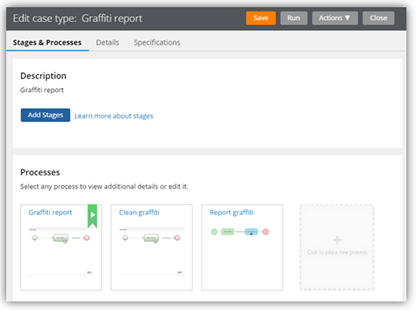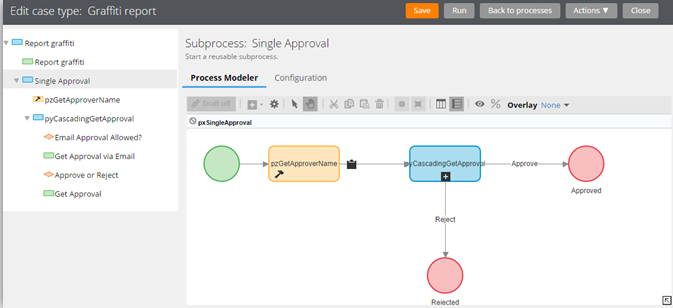Edit process-based case type flows in Case Designer Process Outline view
Valid from Pega Version 7.1.7
If your case type does not employ a stage-based design, you can now employ the Step Tree and other features available in Process Outline view to facilitate your design.
Click a process tile in the Stages & Processes tab to open the flow in Process Outline. In this example, the Graffitti report is selected.

Processes in Stages & Processes tab
The process opens in Process Outline view. Note that the tree view allows you to easily see and update the underlying shapes and subprocess that compose the Single Approval process.

Process in Process Outline view
Create pluggable web storage components for case and Pulse attachments
Valid from Pega Version 7.3
You can now implement and post your own pluggable web storage components for use with case and Pulse attachments. These web components can be plugged in to Pega® Platform without the need to make changes to Pega Platform itself. The ability to create a pluggable web storage component is useful when you want to use a web storage provider that does not have an existing pluggable web storage component.
For more information, see Guidelines for creating pluggable components for storing and sourcing case and Pulse attachments.
Ability to train the text analytics model based on email attachments
Valid from Pega Version 8.6
You can now train the text analytics model for Pega Email Bot™ based on training data from email attachments. As a result, you improve the natural language processing (NLP) analysis for your email bot so that your system detects the correct language, sentiment, topics, and entities from both the body of emails and their attachments. By default, you train the text analytics model based only on training data from the body of emails.
For more information, see Enabling training the model based on email attachments.
Flow action and attachment category rule types moved to Process category
Valid from Pega Version 7.1.7
The flow action and attachment category rule types now appear in the Process category within the Record and Application Explorers. Previously, they were in the User Interface and Security categories, respectively.
Support for extracting data from file attachments during email triage
Valid from Pega Version 7.4
With the Pega® Intelligent Virtual Assistant for Email, when you triage email interaction cases, the system can now use defined text analyzers to detect entities in files that are attached to the received email. The following file types are supported: DOC, DOCX, ODT, PDF, RTF, and TXT. This feature improves the machine learning and case processing capability for the Email user channel.
For more information, see Enabling the analysis of attached files during email triage.
Support for large binary data item storage in Pega Mobile Client and offline case attachments in Pega Platform
Valid from Pega Version 7.4
Pega® Mobile Client can now store and synchronize large binary data items and their corresponding actions from the action queue on Android and iOS devices. As a result, custom mobile app users can view, attach, and delete data files, whether the device is online or offline. For this function to work, you must enable offline case attachment support, which allows your custom mobile apps to synchronize case attachments between the Pega Platform and the mobile device.
For more information, see Enabling offline case attachments support and Client Store API.
Support for large binary data item storage in Pega Client for Windows
Valid from Pega Version 8.2
Pega Client for Windows can now store and synchronize large binary data items and their corresponding actions from the action queue. As a result, offline-enabled application users can view, attach, and delete data files from within a case view, whether the Windows-based device is online or offline. To use this feature, enable offline case attachment support, which allows offline-enabled applications to synchronize case attachments between Pega Platform™ and the device.
For more information, see Attach content support in offline mode and Enabling offline case attachments support.
Enhanced Pulse gadget for Cosmos React
Valid from Pega Version 8.6
Together with the DX API, the Cosmos React component now provides an overlay in which users can quickly view and select the feed sources from which to view Pulse messages. Users can also add attachments to their messages, and remove the messages that they post. These enhancements improve collaboration and speed up case resolution. For example, a case worker can view only posts from particular cases, to quickly find a request for additional information about a case, and then provide necessary details by attaching a relevant document.
For more information, see Configuring Pulse feed sources for Cosmos React and Posting a message in Pulse.
Automatically process cases with Box
Valid from Pega Version 7.2.2
You can now use Box to store attachments during automated case processing without requiring user input at run time for authentication or authorization with Box. The authentication profile must be OAuth 2.0 with a grant type of authorization code. You can view which apps are connected, connect apps, and disconnect apps on the Connected apps landing page.
For more information, see Connected apps landing page.
Task board enhancements for improved tracking of tasks
Valid from Pega Version 8.3
App Studio and end-user portals, such as Case Manager, now provide an enhanced task board which helps you improve collaboration on task resolution. For example, you can create a checklist within a task, and then update the checklist to inform other users about the progress of the task. Attach content to a task to ensure that all users have the information that they need, and to make tasks more meaningful. Now you can also categorize tasks, and then filter them by category, to quickly access relevant information.
For more information, see Monitoring and tracking tasks in Dev Studio, Monitoring and tracking tasks in App Studio.

